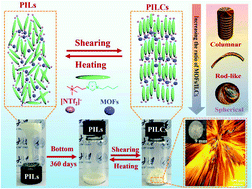Dual stimuli-responsive porous ionic liquids with reversible phase transition behavior based on ionic liquid crystals for CO2 and C2H4 adsorption†
Abstract
The introduction of ionic liquids crystals (ILCs) into porous liquids (PLs) might be an effective way to overcome the problems associated with their processability, such as leakage, packaging, transportation, and long-term stability. Herein, a generalizable strategy to construct stimuli-responsive porous ionic liquids (SRPILs) based on the self-assembly of responsive ILCs and metal–organic frameworks (MOFs) has been demonstrated. The unique rapid reversible transition behaviors of the SRPILs induced by shearing and heating stimuli are verified. Furthermore, the SRPILs exhibited an approximately 3-fold increase in adsorption capacity for CO2 and C2H4 compared with that of the neat ILC solvent, confirming that the accessible porosity was retained in the SRPILs. Remarkably, the stimuli-responsiveness of the SRPILs can be demonstrated through changes in their phase, porosity, gas adsorption, and separation. Benefiting from their stimuli-responsive nature, SRPILs can be regarded as “smart porous liquids”, undoubtedly providing enormous inspiration for the development of new applications, including but not limited to gas capture/separation, sensing, catalysis, and electrochemical applications.



 Please wait while we load your content...
Please wait while we load your content...